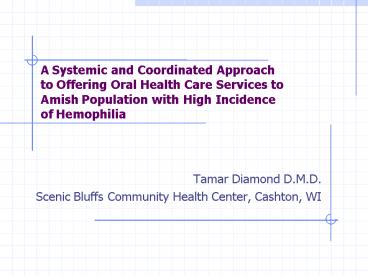A Systemic and Coordinated Approach to Offering Oral Health Care Services to Amish Population with H - PowerPoint PPT Presentation
1 / 16
Title:
A Systemic and Coordinated Approach to Offering Oral Health Care Services to Amish Population with H
Description:
Additional clotting factor needed for routine dental care. Hemophilia in the Amish Population ... Encouraging dental cleanings. Attempting to reduce reliance ... – PowerPoint PPT presentation
Number of Views:115
Avg rating:3.0/5.0
Title: A Systemic and Coordinated Approach to Offering Oral Health Care Services to Amish Population with H
1
A Systemic and Coordinated Approach to Offering
Oral Health Care Services to Amish Population
with High Incidence of Hemophilia
- Tamar Diamond D.M.D.
- Scenic Bluffs Community Health Center, Cashton,
WI
2
Objective
- To highlight special concerns regarding
- oral care for the Amish patient.
3
Background of Clinic and Community
4
Staffing
- There are 52 staff members including
- 1 physician
- 3 dentists
- 2 nurse practitioners
- 1 physician assistant
- 1 chiropractor
- 1 optometrist
- 2 pharmacists
- 4 dental hygienists
5
Economic Impact
- 4 million annual
- business
- Health Centers economic impact on local
communities is 6.2 million on local communities
- Since 1994, Health Centers brought in 6.48
million in federal grant dollars for primary care
in our communities - Since 2001, Health Centers secured 1.10 million
in state grant dollars specifically targeted at
primary care access
6
Health Center Overview
- Section 330 funded Community Health Center -
receive federal grant funds from US Department of
Health and Human Services, Bureau of Primary
Health Care - Have a published sliding fee scale Healthy
Neighbor Plan - Governed by a community based Board of Directors
currently 10 members - Serve a federally designated medically
underserved area
7
Patients and Encounters
8
Other Patient Data
- 90 of patients are white
- 6 are Hispanic
- 44 have Medicaid/BadgerCare insurance
- 26 uninsured
- 50 live at or below the federal poverty level
9
Old Order Amish Community
- Greater demand for emergency care
- Preventive care not as high a priority
- Obstacles in putting patients on recall schedule
10
Caries Triad
- 1. Bacteria
- a. Mother has poor oral health and
bacterial composition in mouth is passed to
child - 2. Host
- a. Importance of brushing teeth is often
not culturally transmitted from parent to child - b. Brushing once a week is not uncommon
- c. Heavy plaque bio-film
- 3. Sugar
- a. Very high sugar diet
- b. Bakery goods, candy, and maple syrup are
part of the livelihoods of families - c. Mountain Dew and other sugary drinks are
very popular
11
Common Incidence of Caries
- Early childhood caries
- Caries on newly erupted teeth
- Caries on 4 surfaces
12
Cultural Barriers to Care
- 1. Misgivings about the restoration of primary
- teeth leading to
- a. Pain
- b. Emergency appointments
- c. Space maintenance issues
- 2. Unwillingness to have dental cleanings
- a. Fear of harming the tooth ("Stripping the
enamel") - b. When asked to schedule cleaning, patient says
that they will call clinic if desired - c. Heavy gingival bleeding during operative
procedures
13
Hemophilia in the Amish Population
- Extensive intermarriage leading to consanguinity
- Bottle neck population
- Recessive genetic diseases become more prominent
- Levels of clotting factor remain stable for life
- Degrees of severity run in the family
- Additional clotting factor needed for routine
dental care
14
Cashton Amish Population
- Tends toward mild to moderate hemophilia
- Moderate 1 - 5 clotting factor of the normal
range - Spontaneous bleeding does not occur, but
prolonged bleeding after injury does occur - Given factor prior to treatment, a patient can
receive the normal range of dental services - Preventive factor improves the clinical prognosis
15
Hemophilia Screening Day
- Begun as a collaboration between the clinic and
the area blood center in nearby La Crosse - Goal is to identify needs of hemophiliac patients
and decrease emergency care situations - Patients register for 15 minute screenings to
determine urgent care needs or potential problems - At the end of the screening, both a medical
appointment and dental appointment are made for
the same day - During the medical appointment, the patient
receives factor - During the dental appointment, the most pressing
dental issues are addressed
16
Conclusion
- We are working to address the needs of this
special population by - Educating parents about the importance of primary
teeth - Encouraging dental cleanings
- Attempting to reduce reliance on emergency
appointments - Increasing awareness of the importance of oral
hygiene in tooth retention and overall health































